Introduction
On Tuesday, October 18, 2011, the much-anticipated animated adaptation of Batman: Year One, the latest DC Comics film produced by Warner Bros. Animation, will be released. Beginning in 2007, Warner Bros. have put out eleven animated films, adapted from DC’s most popular characters and storylines, for the direct-to-DVD market. Supervised by the acclaimed producer Bruce Timm, the chief force behind the legendary Batman: The Animated Series, and other series from the DC Animated Universe continuity, the films are generally standalone works set within their own individual continuities and featuring both highly contrasting styles of two-dimensional animation and varying casts of voice actors. Besides being consistently solid and appealing to fans new and old, the films are mainly interesting for demonstrating the rather diversified and anti-canonical nature of today’s highly postmodern comic book media, where famous characters are consistently reinterpreted by different artists and writers while incorporating the zeitgeist of their times. In the process, they sometimes illustrate both the positives and negatives of that approach.
I’ll, of course, be reviewing the Year One adaptation when it’s comes out next week, but right now here’s an overview, in chronological order, of the DC animated films released so far. (As a note, the DC Animated Original Movies are different from the DC Animated Universe, or DCAU, which covers Batman: The Animated Series, Superman: The Animated Series, Batman Beyond, Justice League, and Justice League Unlimited.)
Superman: Doomsday (2007)

A very loose adaptation of the bestselling (and polarizing) “Death of Superman” saga, the film relates the Man of Steel’s “fatal” clash with the unstoppable “intergalactic soccer hooligan” Doomsday, and the subsequent aftermath of his death. The title is actually something of a misnomer, as the build up and battle with Doomsday only takes up the first fifteen minutes of the 75 minute film; the bulk of the story actually involves the hero’s mysterious return from the dead, and the grieving Lois Lane’s attempts to reveal that the new “Superman” is actually a clone created by Lex Luthor. Of course, the real Superman does eventually return from the dead, building to a final battle between Luthor’s evil imposter and the genuine, resurrected Man of Tomorrow. There’s a lot to like in this one, in that it offers a far more sophisticated and adult interpretation (especially in its dialogue) of the Man of Steel unseen in other animated interpretations. Adam Baldwin is a good Superman, and even better as the evil clone, and James Marsters proves outstanding voicing a very erudite and creepy Luthor who’s pathologically obsessed with his nemesis, but the overall story is really pretty thin and overall very predictable. It does feature an amusing voice cameo by Kevin Smith. Mildly recommended.
Justice League: The New Frontier (2008)
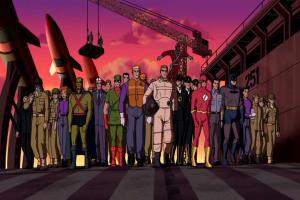
An adaptation of Darwyn Cooke’s outstanding DC: The New Frontier, this one is a bit divisive for me. In Cooke’s excellent graphic novel, he provided a fictionalized reinterpretation of the origins of DC’s Silver Age, which began in the late 1950s with the introduction of the new Green Lantern Hal Jordan and the new Flash Barry Allen, as well as a little superhero group called the Justice League. Set in the 1950s during the Cold War, both book and film relate the formation of the team while facing an unstoppable monster called the Centre (which, like most things set during the 1950s, is a metaphor for Communism). The film does a decent job of cutting the 12 part Graphic Novel into a 75 minute animated film, but unfortunately it does so while jettisoning many of the themes and historical touches that made Cooke’s work so remarkable. With that said, it’s still a good watch, as the animation and character designs are pretty spectacular and the voice work impeccable, with Kyle McLachlan as Superman, Lucy Lawless as Wonder Woman, a great Neil Patrick Harris as Barry Allen/the Flash, and, in a pleasant surprise, David Boreanaz as a really good Eisenhower-era Hal Jordan. Recommended, but not in place of reading the original graphic novel.
Batman: Gotham Knight
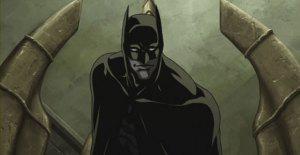
This one was a pretty good idea that just didn’t work. Taking a cue from 2003’s The Animatrix, this presented a series of six short Batman stories and vignettes, each penned by a different writer and then interpreted by a different director from the world of Japanese anime. The results, unfortunately, are a very mixed bag, and in the process of transposing the anime style they reveal much of the good and the bad aspects of the medium. Like The Animatrix was for The Matrix films, the stories for Gotham Knight are ostensibly set between the events of Batman Begins and The Dark Knight, and that’s part of the problem in that the pieces are all part of a broader continuity yet are so aesthetically different that watching them together takes you out of the broader story. It isn’t helped by the fact that the quality of animation varies wildly, and even in the best of cases displays the poor dubbing, clichéd freeze frames, and the limited cell animation that are often criticized in anime. Kevin Conroy, whose vocal interpretation as the Dark Knight may be the best ever, returned here as Batman, but he’s unfortunately all wrong for the younger, Christian Bale-like Batman they’re trying to portray here. Not recommended.
Wonder Woman
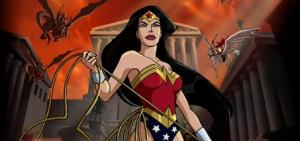
Probably the closest thing we’re going to get to a Wonder Woman film for the next few years (which may not be a bad thing), this ended up being a fairly flat origin story for the eponymous superheroine (voiced by Keri Russell). Based mainly on George Perez’s work reintroducing the character in late 1980s, the film tells the story of Princess Diana of Themyscira, the island of the ageless Amazons, who after a lifetime of seclusion wins the right to escort the stranded pilot Steve Trevor back into the modern “man’s world.” Whilst being given valuable insight into modern society, Diana eventually finds herself having to stop the evil God of War Ares (voiced by Alfred Molina) from destroying the world. While the animation is typically strong and the voice cast is very good (especially Nathan Fillion as an especially rakish Steve Trevor), I kind of hated this one. It’s overly violent, to the point of being overcompensating, the story is somewhat flat, and the ultimate message, that all women need men to define them, is actually pretty antifeminist for what is supposed to be the feminist superhero. Not recommended.
Green Lantern: First Flight
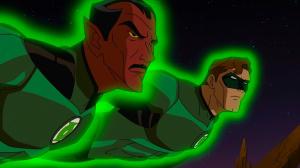
This one actually took me quite by surprise, especially after what were the disappointing efforts of the other DC films up to that point. First Flight relates the origins of Hal Jordan, Earth’s Green Lantern (voiced by Christopher Meloni), after he has arrived for training on Oa, home planet for the Guardians of the Universe. Taken under the wing of the most decorated of the Lantern Corps, the earnest Jordan soon proves himself worthy of his power ring and earns the respect of his peers. His mentor, meanwhile, takes a fall from grace, becoming the evil rogue Lantern Sinestro (a fine Victor Garber). Plotted like an intergalactic cop film, it boasts strong acting, animation, and action, and provides a far better portrayal of the Jordan character and his mythology than the recent Ryan Reynolds film (which I eviscerate here). Recommended.
Superman/Batman: Public Enemies
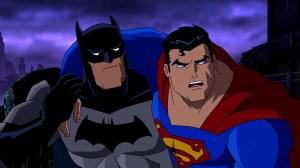
The first direct adaptation by the DC Animated team of a mainstream continuity storyline, Public Enemies was a fairly faithful adaptation of “The World’s Finest” storyline (originally written by Jeph Loeb) that took up the first six issues of the relaunched Superman/Batman comic book series. Living in a world where Lex Luthor has been elected President of the United States, the world’s two greatest superheroes soon find themselves framed for the murder of a reformed supercriminal. With a billion dollar bounty on their heads, both Superman and Batman must clear their names while an army of supervillains and a team of governmentsponsored superheroes are hot on their heels. Meanwhile, an increasingly irrational President Luthor must contend with a giant meteorite hurtling towards Earth. Though Superman and Batman are my two favorite superheroes, I’ve never been a huge fan of this storyline, thanks to some of its more controversial elements (I use “controversial” in the fanboy sense), which included a fairly polarizing sequence where Superman and Batman beat up almost the entire DC villain roster (basically making them all look like a bunch of chumps in the process) and the multiyear President Luthor storyline ending rather abruptly and unimaginatively. Unfortunately, the best part of the Superman/Batman comic, the contrasting first person narrations of the two heroes, is lost in adaptation, leaving the kind of weird, overly cartoonish superhero storyline that generally alienates non-fans. The best part of the film ultimately is the reunion of the DC Animated Universe (the animated series continuity) voice cast of Kevin Conroy as Batman, Tim Daly as Superman, and Clancy Brown as Lex Luthor. The character designs are pretty meticulously taken from Ed McGuinness’s original illustrations, but they unfortunately don’t lend themselves to animation. Not recommended.
Justice League: Crisis on Two Earths
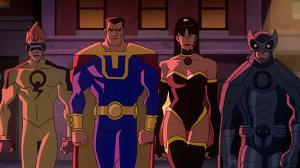
Another surprisingly good effort, based on DC’s recurring storyline of the Earth-2/Antimatter Universe, or basically DC’s version of Star Trek’s mirror universe, where what is good is evil and vice versa. Adapted from what was supposed to be the bridge between the Justice League and Justice League Unlimited series by DCAU writer Dwayne McDuffie, the film relates the story of the alternate universe Lex Luthor (voiced by Chris Noth), who in his universe is the only remaining superhero, traveling to the mainstream universe to recruit the Justice League in stopping their evil counterparts the Crime Syndicate. A clichéd idea, but one almost perfectly executed, with excellent characterizations, dialogue, plotting, and wall to wall action. Some really great voice work, too, especially by James Woods as Owlman, Batman’s nihilistic doppelganger. Recommended.
The film was released with a “DC Showcase” short film, “The Spectre,” an excellent adaptation of the title character who as the Spirit of Vengeance, goes into action when a wealthy movie producer is mysteriously murdered. A great little piece that captures a seedly LA atmosphere and the look of a seventies cop show (right down to “scratching” the film), combined with touches of supernatural horror. Gary Cole does a fantastic job voicing Jim Corrigan, the LAPD detective with a mysterious link to the malevolent ghost,
Batman: Under the Red Hood

Without a doubt the best of the DC Animated films to date, and the best animated Batman since the DCAU, this adapted the mainstream DC universe storyline “Under the Hood,” which related the return from the dead of Jason Todd, the second Robin. Writen by the storyline’s original writer Judd Winick, the film first relates Jason’s vicious death at the hands of the Joker, and then rejoins the Dark Knight (voiced by Bruce Greenwood) some years later as a new player, calling himself the Red Hood (which was the Joker’s original criminal alias) has moved into Gotham City. Part criminal mastermind and part ruthless vigilante, the Red Hood (Jensen Ackles) has targeted Gotham’s reigning crime lord, the volatile Black Mask, stealing territory, executing lieutenants in grisly fashion, and basically instigating a city-wide gang war. Suspecting that the Red Hood is somehow his former protégé, Batman is forced to confront his past with Jason, and the guilt he feels not only for letting Jason die, but for recruiting the unstable young man in the first place. Wisely, the story doesn’t really waste time building suspense over whether the Red Hood really is Jason Todd; instead it focuses on the pain and emotion the situation causes for both characters, as well as the intriguing and provocative contrast in philosophies between the deontological Batman and the coldblooded utilitarianism of the Red Hood. An altogether terrific film, featuring superb animation and character design, terrific atmosphere, and thrilling action. Some damn fine voice work, too, with Greenwood proving a worth heir to Kevin Conroy (he currently voices Batman in Young Justice) and John DiMaggio (best known for voicing Bender on Futurama) quite a revelation in a pivotal role as a genuinely unnerving Joker. High recommendation.
This release came with a “Jonah Hex” short. Written by Joe Bob Briggs, it tells a great little violent story of Hex (Thomas Jane), the old West bounty hunter with a half-scarred face, matching wits with an especially evil madame (Linda Hamilton).
Superman/Batman: Apocalypse

A direct sequel to Public Enemies, with Conroy and Daly again reprising their roles, this film adapts the Superman/Batman storyline “Supergirl.” After the Kryptonite meteorite that threatened Earth has been destroyed, a mysterious craft crash lands in Gotham harbor. Inside is a pretty young Kryptonian girl who turns out to Kara Zor-El (Summer Glau), Superman’s cousin and the only other survivor of the destruction of Krypton. The plot involves Superman bonding with his cousin as she becomes acclimated to being an “Earth girl,” though she faces the mistrust of Batman and the harsh training of Wonder Woman (Susan Eisenberg, also reprising her Wonder Woman from DCAU) and the Amazons, as well as the attentions of the God of Evil, Darkseid (a miscast Andre Braugher). Again, the title is a bit of a misnomer, as the story is just a retelling of the Post-Crisis on Infinite Earth introduction of Supergirl (at least the Kryptonian version) rather than anything involving the end of the world (though the action part of the story does take place on Darkseid’s home planet Apokolips). As a sequel, it’s an improvement over the previous installment; the animation is superior and much of the action is extremely well choreographed. Admittedly, I’m always a sucker for Superman battling Darkseid. With that said, it’s pretty much a Superman story first and foremost, with Batman being regulated to something of a guest role (as with Wonder Woman), and the plot feels almost more like a video game than a movie. Very mild recommendation.
The film was released with the DC showcase short “Green Arrow,” which presented a pretty straight-forward action story of the Emerald Archer (voiced by Neal McDonough) defending a young royal heiress from assassination by the evil archer Merlyn (Malcolm McDowell). Some good action, even if it is just an extended set piece.
DC Showcase Original Shorts Collection: Superman/Shazam! – The Return of Black Adam
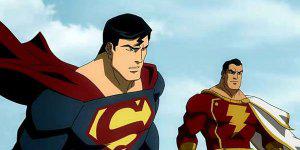
This was a one-off set of the three previosuly released shorts combined with the 22 minute “Superman/Shazam!” piece, which was a short form recounting of the origins of Captain Marvel (voiced by Jerry O’Connell, reprising his guest spot from Justice League Unlimited): Plucky young orphan Billy Batson, who’s tireless enthusiasm in the face of a life of hardship, earns himself the favor of the wizard Shazam, who in turn selects young Billy as his super powered champion, Captain Marvel. And just in time, too, as Shazam’s previous choice, the corrupted Black Adam, has just returned from a 5000 year exile, looking for revenge. I’ve always had a soft spot for Captain Marvel (he was one of my Dad’s favorite superheroes when he was growing up), but this was very disappointing, and far too short, especially since Superman (George Newbern, also reprising his Justice League/JLU role) feels shoehorned in for the sake of marketing (and essentially gives the heroes a weird, two-on-one advantage). Recommended as a set given the quality of the other three pieces, but not worth getting just for the “Shazam” short.
All Star Superman
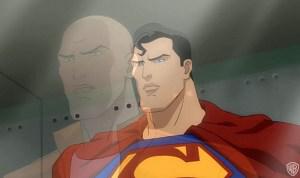
A fairly faithful adaptation of Grant Morrison’s acclaimed miniseries of the same name, All Star Superman tells something of a speculative narrative of the last days of the Man of Steel. Poisoned by excessive solar radiation due to the machinations of Lex Luthor (Anthony LaPaglia), Superman (James Denton) must put his proverbial affairs in order, including trying to reveal his secret identity to his beloved Lois Lane (Christina Hendricks) and finding a new home for the bottle city of Kandor. A poignant anthology of stories that harkens back to many past elements of Superman’s history and mythos, All Star is a must see (as well as a must read) for any Superman fan, capturing the romantic idealism that has defined the Man of Tomorrow over his 70 years of existence. Really brilliant animation, terrific characterizations, along with a touching finale, though having to keep the film to 75 minutes meant cutting out some of the best segments of Morrison’s original miniseries. Sadly, this was released only a few days after its scribe Dwayne McDuffie, who was a longtime writer for DC’s animated media, passed away at age 49, making the film’s elegiac tone all the more resonant. All Star Superman is definitely worth seeing, preferably as a compliment to the original comic. High recommendation.
Green Lantern: Emerald Knights
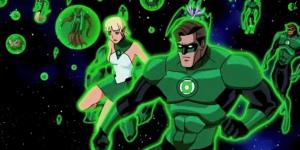
Another anthology series similar to Batman: Gotham Knight, released to tie into the recent Green Lantern film, the story relates Hal Jordan (Nathan Fillion, whom many a geek dreamed of seeing play the live action version), mentoring a fresh faced new Lantern recruit named Arisia Rrab, when the monstrous Krona threatens to cross over from the Anti-Matter Universe to destroy our own. As the Corps musters their strength to prepare for the ultimate battle, Jordan and the other Lanterns share their stories and history with the new recruit, who fears she’s unworthy of the honor of being a Lantern. All told, Emerald Knights is a superior endeavor to Gotham Knight, since it covers a variety of characters and stories within the Green Lantern universe while remaining stylistically consistent throughout. Recommended.

